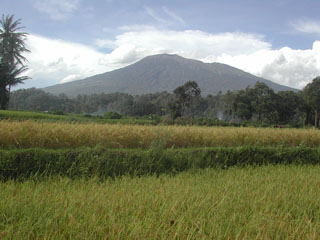Report on Marapi (Indonesia) — 31 August-6 September 2022
Smithsonian Institution / US Geological Survey
Weekly Volcanic Activity Report, 31 August-6 September 2022
Managing Editor: Sally Sennert.
Please cite this report as:
Global Volcanism Program, 2022. Report on Marapi (Indonesia) (Sennert, S, ed.). Weekly Volcanic Activity Report, 31 August-6 September 2022. Smithsonian Institution and US Geological Survey.
Marapi
Indonesia
0.38°S, 100.474°E; summit elev. 2885 m
All times are local (unless otherwise noted)
In a special notice posted on 2 September PVMBG reported that tiltmeter deformation data for Marapi showed a trend of inflation at the summit and deflation along the flanks. Seismicity continued to fluctuate with the dominating signal indicating hydrothermal activity. A phreatic eruption was the most likely kind of volcanic activity that could occur at the volcano, based on the recent data, and it could occur without warning; PVMBG reminded the public to stay at least 3 km away from the summit. The Alert Level remained at 2 (on a scale of 1-4).
Geological Summary. Gunung Marapi, not to be confused with the better-known Merapi volcano on Java, is Sumatra's most active volcano. This massive complex stratovolcano rises 2,000 m above the Bukittinggi Plain in the Padang Highlands. A broad summit contains multiple partially overlapping summit craters constructed within the small 1.4-km-wide Bancah caldera. The summit craters are located along an ENE-WSW line, with volcanism migrating to the west. More than 50 eruptions, typically consisting of small-to-moderate explosive activity, have been recorded since the end of the 18th century; no lava flows outside the summit craters have been reported in historical time.
Source: Pusat Vulkanologi dan Mitigasi Bencana Geologi (PVMBG, also known as CVGHM)

